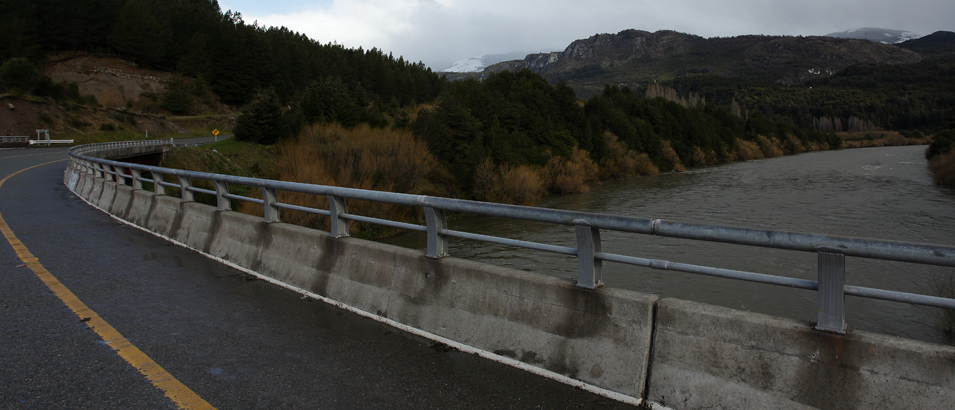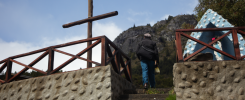They say that it was the Jesuit Nicolás Mascardi, who gave the name of Palena to this area located in the Andean Patagonia. It is recognized for its ideal conditions for fly fishing, the Palena National Park and for its peaceful rural life.

History
Palena, is a commune crossed by rivers which separate or unite, depending on who you ask. It was recognized, in 1929, as Palena District, giving its name to the Province. Although there is the town of Alto Palena, administrative center of the commune, many Palenenses are dedicated to livestock in the rural areas. But both the inhabitants of the town and those of the most remote localities say they lead a life marked by being so close to the border, far from the urban centers and the ocean, together with the Argentine neighbors with whom they share part of their history and their traditions.
During the Spanish conquest period, several explorers advanced through the territories around the Palena River. They were looking for lands to settle on, as well as riches of a mythical city, the City of the Caesars. But due to the harshness of the weather and a difficult geography, the valleys, such as the California and the banks like those of the Encuentro River, were uninhabited for centuries. The explorers were guided by the native Tehuelches, who knew the territory but did not live in it permanently or had been forced to abandon it. However, the dense forest and the rushing currents forced the explorers to return.

Unable to find the City of The Caesars, explorations along the Palena River decreased, increasing again in the mid-nineteenth century, with the independence of Chile and the annexation of Chiloé. But with a different purpose this time: the Chilean State and the Argentinean State wanted to recognize the territory and colonize it, fighting over it for almost a hundred years.
On this side of the mountain range, this task was assigned to the Navy. They organized several exploratory expeditions through the different rivers of Patagonia. In 1893 the most important exploration of the Palena River is carried out by Professor Hans Steffen. In this excursion, a previously unknown tributary of the Palena River was discovered. Steffen would call it “Encuentro” (Meeting), having met there with a group of his explorers who came down from Osorno. In the coming decades, the Encuentro River would be the centre of the border controversy between Chile and Argentina.
In 1876, Argentina had passed a law allowing the Chilean settlers to occupy Patagonian lands. But at the beginning of the new century, the Argentinean government was concerned about the occupation of territories considered as its own. They were interested in these rich lands; the police harassed and expelled the Chilean settlers. The chilean government attracted Chilean settlers from Argentina by offering plots of land in Chaitén, Futaleufú and Palena.

The first families arriving were the Casanova, the Balboa, the Sáez and the Carrillo. Antonio Balboa looking at the valley opening in front of them, baptized it with the name of California, which reminded him of the landscape described in the stories of the literary hero “Juan Tresdedos”, in the North American California.
From the beginning, the new inhabitants developed a true border culture. Being Chileans coming from Argentina, they brought with them the tradition of the Chilean farmer mixed with the gaucho traditions: the “pialadura”, the “señaladas”, the “truco”, the game of the “vistiada”, the music and the way they dress are some examples. However, the people from Palena also feel that they are making Chile their homeland. The true settlement of the Palena area begins around 1911, with these settlers who were searching for their country and territory.
In Palena people have a deep pride for the beautiful landscape surrounding them, but also for being able to tame it, opening the forest and converting it into farmland. Having decided to stay in Chile and not in Argentina, these settlers suffered from the isolation. They were making their way into a territory often hostile, living on livestock and agriculture.
The people of Palena built their houses with lenga and cypress trees they had struck down. When it was not the axe, the fire helped them open space for the livestock. They lived on potatoes, wheat, beans, and peas, and dressed in burlap clothes, made by themselves.

Livestock was essential throughout those years. The first settlers installed on the shore of the Encuentro River had been looking for good summer grassland for their livestock, besides settling on the precious land.
They lived in isolation, both economically and administratively. That is why don Eliodoro Díaz, one of the first inhabitants of these valleys, is so remembered. Don Eliodoro organized civil life in the rising town of Alto Palena and was appointed in 1928 as district judge by the governor of Aysén, Police Colonel Luis Marchant González. Don Eliodoro acted as the notary for the whole area of Palena, registering brands, issuing birth or death certificates, and attesting civil contracts.
Don Eliodoro was key for Palena to be declared a District by Luis Marchant himself, in 1929. During the 1930s the border was considered definitively closed, and the inhabitants no longer depended on the Argentinean authorities. However, the people of Palena still crossed into the neighbouring country, trying to make their livelihood, looking for a family and work, and the border conflicts would continue for three more decades.
Despite the official foundation of Palena, the isolation would last much longer. During the sixties, the commune became, once again, the epicentre of the disputes between Chile and Argentina. The Argentinean government surrounded with wired fences the territory that they considered to be theirs, until Queen Isabel II gave an arbitral judgement ending with the conflict around the California valley. The process had a lot of coverage at the national level, and the isolated Palena commune became known. The conflict was so relevant that in 1966, President Eduardo Frei Montalva arrived in the valley.

During the seventies, one of the ways to reach Alto Palena quickly, which by the time already had a school, healthcare services and police, was by the plane “El Caiquén”. The light aircraft carried people in case of emergency. Over time the roads connecting the different sectors of the commune would open, walkways were built, and rafts were built to cross the rivers. In recent decades, and as it occurred throughout the Province, the arrival of the Carretera Austral brought with it greater connectivity, and the possibility of advancing in a local tourism industry.
Today Palena stands in the middle of magnificent mountains and surrounded by rivers, inviting visitors to learn about its border culture, the weavers, and farmers of this land. Invites them to walk its paths, navigate lakes and to share stories together, next to the fire, sharing of course, a good mate.

